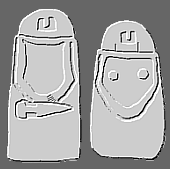 Group A
Group A
The statues belonging to this group are very schematic and they are practically more stelae than
statues.
The anthropomorphic traits are realized with extreme simplicity and detail
avarice:
they have the head fully connected with the body, U-shaped face, a straight clavicular line and two
arms. The fingers of the
hands are represented in few monuments only.
The masculine statues show a poignard, drawn with its profile only, with a triangular
blade, a short handle and a semi-circular pommel.
The feminine statues are represented with separated breasts made as small disks.
The nine statues of Pontevecchio, found all togheter aligned, belong to this
group.
EXAMPLES : -----